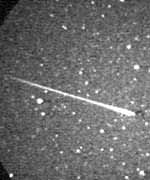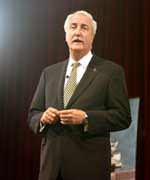Two of the biggest physics breakthroughs during the last decade are the discovery that wispy subatomic particles called neutrinos actually have a small amount of mass and the detection that the expansion of the universe is actually picking up speed.
Now three University of Washington physicists are suggesting the two discoveries are integrally linked through one of the strangest features of the universe, dark energy, a linkage they say could be caused by a previously unrecognized subatomic particle they call the “acceleron.”
Dark energy was negligible in the early universe, but now it accounts for about 70 percent of the cosmos. Understanding the phenomenon could help to explain why someday, long in the future, the universe will expand so much that no other stars or galaxies will be visible in our night sky, and ultimately it could help scientists discern whether expansion of the universe will go on indefinitely.
In this new theory, neutrinos are influenced by a new force resulting from their interactions with accelerons. Dark energy results as the universe tries to pull neutrinos apart, yielding a tension like that in stretched rubber band, said Ann Nelson, a UW physics professor. That tension fuels the expansion of the universe, she said.
Neutrinos are created by the trillions in the nuclear furnaces of stars such as our sun. They stream through the universe, and billions pass through all matter, including people, every second. Besides a minuscule mass, they have no electrical charge, which means they interact very little, if at all, with the materials they pass through.
But the interaction between accelerons and other matter is even weaker, Nelson said, which is why those particles have not yet been seen by sophisticated detectors. However, in the new theory, accelerons exhibit a force that can influence neutrinos, a force she believes can be detected by a variety of neutrino experiments already operating around the world.
“There are many models of dark energy, but the tests are mostly limited to cosmology, in particular measuring the rate of expansion of the universe. Because this involves observing very distant objects, it is very difficult to make such a measurement precisely,” Nelson said.
“This is the only model that gives us some meaningful way to do experiments on earth to find the force that gives rise to dark energy. We can do this using existing neutrino experiments.”
The new theory is advanced in a paper by Nelson; David Kaplan, also a UW physics professor; and Neal Weiner, a UW research associate in physics. Their work, supported in part by a grant from the U.S. Department of Energy, is detailed in a paper accepted for publication in an upcoming issue of Physical Review Letters, a journal of the American Physical Society.
The researchers say a neutrino’s mass can actually change according to the environment through which it is passing, in the same way the appearance of light changes depending on whether it’s traveling through air, water or a prism. That means that neutrino detectors can come up with somewhat different findings depending on where they are and what surrounds them.
But if neutrinos are a component of dark energy, that suggests the existence of a force that would reconcile anomalies among the various experiments, Nelson said. The existence of that force, made up of both neutrinos and accelerons, will continue to fuel the expansion of the universe, she said.
Physicists have pursued evidence that could tell whether the universe will continue to expand indefinitely or come to an abrupt halt and collapse on itself in a so-called “big crunch.” While the new theory doesn’t prescribe a “big crunch,” Nelson said, it does mean that at some point the expansion will stop getting faster.
“In our theory, eventually the neutrinos would get too far apart and become too massive to be influenced by the effect of dark energy any more, so the acceleration of the expansion would have to stop,” she said. “The universe could continue to expand, but at an ever-decreasing rate.”
Original Source: University of Washington News Release


